Side light FIAT STILO 2006 1.G Owners Manual
[x] Cancel search | Manufacturer: FIAT, Model Year: 2006, Model line: STILO, Model: FIAT STILO 2006 1.GPages: 274, PDF Size: 4.76 MB
Page 232 of 274

231
WARNING
LIGHTS AND
MESSAGES
TECHNICAL
SPECIFICATIONS
INDEX
DASHBOARD
AND CONTROLS
SAFETY
DEVICES
CORRECT USE
OF THE CAR
IN AN
EMERGENCY
CAR
MAINTENANCE
WINDSCREEN/
REAR WINDOW
WIPERS
BLADES
Periodically clean the rubber part using
special products; TUTELA PROFES-
SIONAL SC 35is recommended.
If the rubber blades are bent or worn they
should be replaced. In any case they
should be changed once a year.
A few simple notions can reduce the pos-
sibility of damage to the blades:
❒ if the temperature fall below zero,
make sure that ice has not frozen the
rubber against glass. If necessary, thaw
using an antifreeze product;
❒remove any snow from the glass: in ad-
dition to protecting the blades, this pre-
vents effort on the motor and over-
heating;
❒do not operate the windscreen and
rear window wipers on dry glass.Changing the windscreen
wiper blades
Proceed as follows:
❒raise the windscreen wiper arm A-fig.
22and position the blade so that it
forms an angle of 90° with the arm;
❒press tab Bof the coupling spring and
remove the blade to be replaced from
the arm A;
❒fit the new blade by inserting the tab in-
to the special slot in the arm. Make sure
it is properly locked into place.For certain versions, to replace the blades
proceed as follows:
❒raise the windscreen wiper arm and po-
sition the blade so that it forms an an-
gle of 90° with the arm;
❒press tabs A-fig. 23(set aside the
blade) and remove the blade to be re-
placed from the arm;
❒fit the new blade and check it is prop-
erly locked into place.
Driving with worn wiper
blades is a serious hazard,
because visibility is reduced in bad
weather.
WARNING
fig. 22F0C0162mfig. 23F0C0507m
Page 234 of 274
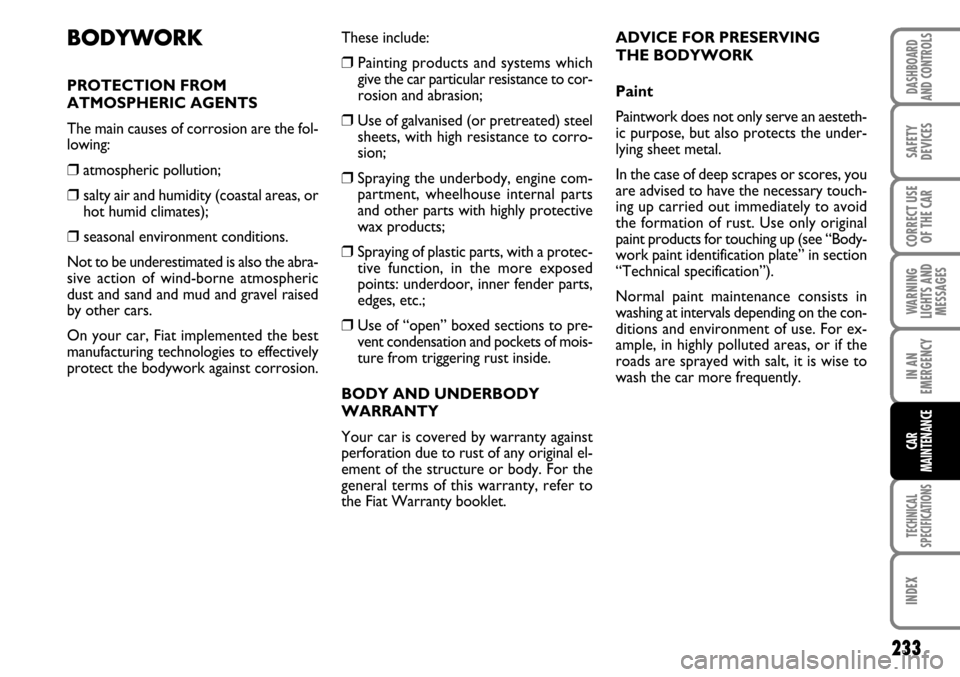
233
WARNING
LIGHTS AND
MESSAGES
TECHNICAL
SPECIFICATIONS
INDEX
DASHBOARD
AND CONTROLS
SAFETY
DEVICES
CORRECT USE
OF THE CAR
IN AN
EMERGENCY
CAR
MAINTENANCE
BODYWORK
PROTECTION FROM
ATMOSPHERIC AGENTS
The main causes of corrosion are the fol-
lowing:
❒atmospheric pollution;
❒salty air and humidity (coastal areas, or
hot humid climates);
❒ seasonal environment conditions.
Not to be underestimated is also the abra-
sive action of wind-borne atmospheric
dust and sand and mud and gravel raised
by other cars.
On your car, Fiat implemented the best
manufacturing technologies to effectively
protect the bodywork against corrosion.These include:
❒ Painting products and systems which
give the car particular resistance to cor-
rosion and abrasion;
❒Use of galvanised (or pretreated) steel
sheets, with high resistance to corro-
sion;
❒Spraying the underbody, engine com-
partment, wheelhouse internal parts
and other parts with highly protective
wax products;
❒Spraying of plastic parts, with a protec-
tive function, in the more exposed
points: underdoor, inner fender parts,
edges, etc.;
❒Use of “open” boxed sections to pre-
vent condensation and pockets of mois-
ture from triggering rust inside.
BODY AND UNDERBODY
WARRANTY
Your car is covered by warranty against
perforation due to rust of any original el-
ement of the structure or body. For the
general terms of this warranty, refer to
the Fiat Warranty booklet.ADVICE FOR PRESERVING
THE BODYWORK
Paint
Paintwork does not only serve an aesteth-
ic purpose, but also protects the under-
lying sheet metal.
In the case of deep scrapes or scores, you
are advised to have the necessary touch-
ing up carried out immediately to avoid
the formation of rust. Use only original
paint products for touching up (see “Body-
work paint identification plate” in section
“Technical specification”).
Normal paint maintenance consists in
washing at intervals depending on the con-
ditions and environment of use. For ex-
ample, in highly polluted areas, or if the
roads are sprayed with salt, it is wise to
wash the car more frequently.
Page 235 of 274

234
WARNING
LIGHTS AND
MESSAGES
TECHNICAL
SPECIFICATIONS
INDEX
DASHBOARD
AND CONTROLS
SAFETY
DEVICES
CORRECT USE
OF THE CAR
IN AN
EMERGENCY
CAR
MAINTENANCE
To correctly wash the car:
❒ remove the aerial from the roof to pre-
vent damage to it if the car is washed in
an automatic system;
❒wash the body using a low pressure jet
of water;
❒ wipe a sponge with a slightly soapy so-
lution over the bodywork, frequently
rinsing with the sponge;
❒ rinse well with water and dry with a jet
of air or a chamois leather.
When drying, take particular care with the
less visible parts like door surrounds, bon-
net and around the headlights where wa-
ter may stagnate. The car should not be
taken to a closed area immediately, but left
in the open so that residual water can
evaporate.Exterior plastic parts must be cleaned in
the same way as the rest of the car.
Where possible, do not park under trees;
the resinous substance many species re-
lease give the paint a dull appearance and
increase the possibility of triggering rust
processes.
IMPORTANT Bird droppings must be
washed off immediately and thoroughly as
the acid they contain is particularly ag-
gressive.Front headlights
IMPORTANT Never use aromatic sub-
stances (e.g.: petrol) or ketones (e.g.: ace-
tone) for cleaning front headlight plastic
lens.
Windows
Use specific window cleaner products.
Use also clean cloths to avoid scratching
the glass or damaging the transparency.
IMPORTANT The inside of the
rearscreen should be wiped gently with a
cloth in the direction of the filaments to
avoid damaging the heating device.
Engine compartment
At the end of the winter the engine com-
partment should be carefully washed,
without directing the jet against electron-
ic control units. Contact a specialised
workshop to have this done.
IMPORTANT The car should be washed
with the engine cold and the ignition key
at STOP. After washing make sure that
the various protections (e.g. rubber caps
and various covers) have not been dam-
aged or removed. Detergents cause water
pollution. Therefore the car
should be washed in areas
equipped for collecting and
purifying the liquid used in the wash-
ing process.
Do not wash the car after it has been left
in the sun or with the bonnet hot: this may
alter the shine of the paintwork.
Page 237 of 274
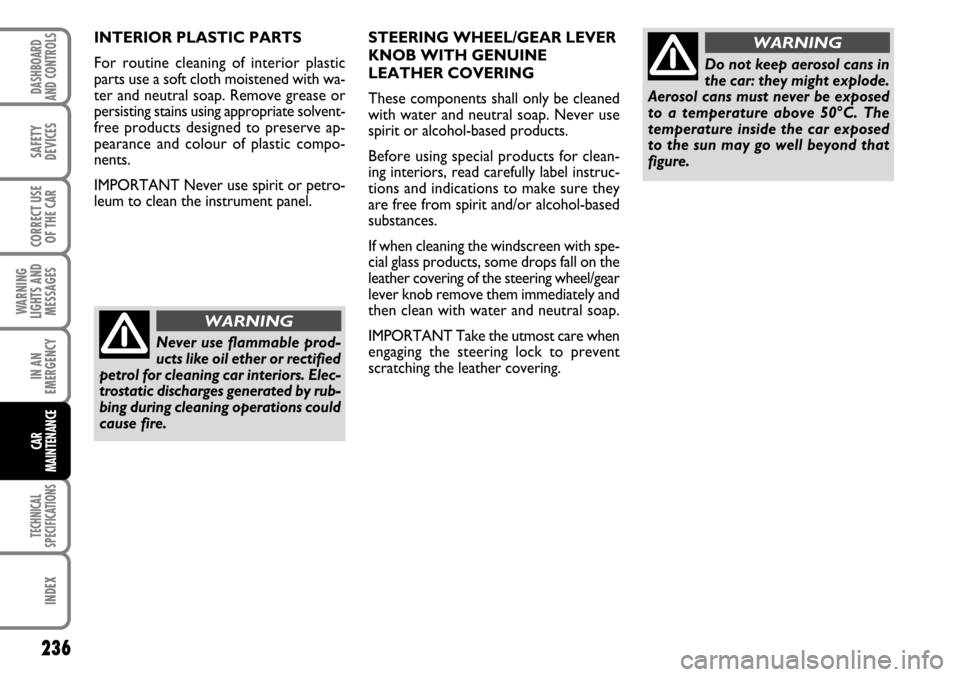
236
WARNING
LIGHTS AND
MESSAGES
TECHNICAL
SPECIFICATIONS
INDEX
DASHBOARD
AND CONTROLS
SAFETY
DEVICES
CORRECT USE
OF THE CAR
IN AN
EMERGENCY
CAR
MAINTENANCE
INTERIOR PLASTIC PARTS
For routine cleaning of interior plastic
parts use a soft cloth moistened with wa-
ter and neutral soap. Remove grease or
persisting stains using appropriate solvent-
free products designed to preserve ap-
pearance and colour of plastic compo-
nents.
IMPORTANT Never use spirit or petro-
leum to clean the instrument panel.STEERING WHEEL/GEAR LEVER
KNOB WITH GENUINE
LEATHER COVERING
These components shall only be cleaned
with water and neutral soap. Never use
spirit or alcohol-based products.
Before using special products for clean-
ing interiors, read carefully label instruc-
tions and indications to make sure they
are free from spirit and/or alcohol-based
substances.
If when cleaning the windscreen with spe-
cial glass products, some drops fall on the
leather covering of the steering wheel/gear
lever knob remove them immediately and
then clean with water and neutral soap.
IMPORTANT Take the utmost care when
engaging the steering lock to prevent
scratching the leather covering.
Do not keep aerosol cans in
the car: they might explode.
Aerosol cans must never be exposed
to a temperature above 50°C. The
temperature inside the car exposed
to the sun may go well beyond that
figure.
WARNING
Never use flammable prod-
ucts like oil ether or rectified
petrol for cleaning car interiors. Elec-
trostatic discharges generated by rub-
bing during cleaning operations could
cause fire.
WARNING
Page 240 of 274

BODYWORK PAINT
IDENTIFICATION PLATE fig. 4
The plate is applied inside the bonnet and
it bears the following data:
A- Paint manufacturer.
B- Colour name.
C- Fiat colour code.
D- Respray and touch up code.ENGINE MARKING
Engine marking is stamped on the cylinder
block and includes the model and the
chassis number.
CHASSIS MARKING fig. 3
It is printed on the passenger compart-
ment floor, near the right-hand front seat.
It can be reached by lifting the special flap
in the carpeting and includes the following
data:
❒car model (ZFA 192000);
❒ chassis number.
239
WARNING
LIGHTS AND
MESSAGES
INDEX
DASHBOARD
AND CONTROLS
SAFETY
DEVICES
CORRECT USE
OF THE CAR
IN AN
EMERGENCY
CAR
MAINTENANCE
TECHNICAL
SPECIFICATIONS
fig. 4F0C0100m
fig. 3F0C0110m
Page 246 of 274
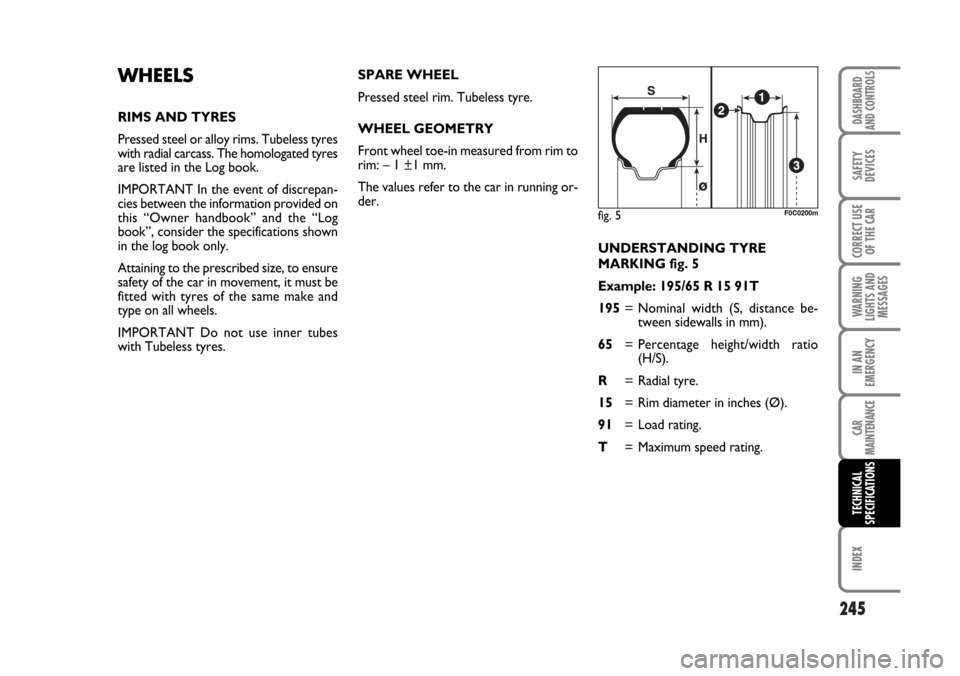
245
WARNING
LIGHTS AND
MESSAGES
INDEX
DASHBOARD
AND CONTROLS
SAFETY
DEVICES
CORRECT USE
OF THE CAR
IN AN
EMERGENCY
CAR
MAINTENANCE
TECHNICAL
SPECIFICATIONS
UNDERSTANDING TYRE
MARKING fig. 5
Example: 195/65 R 15 91T
195= Nominal width (S, distance be-
tween sidewalls in mm).
65= Percentage height/width ratio
(H/S).
R= Radial tyre.
15= Rim diameter in inches (Ø).
91= Load rating.
T= Maximum speed rating.
WHEELS
RIMS AND TYRES
Pressed steel or alloy rims. Tubeless tyres
with radial carcass. The homologated tyres
are listed in the Log book.
IMPORTANT In the event of discrepan-
cies between the information provided on
this “Owner handbook” and the “Log
book”, consider the specifications shown
in the log book only.
Attaining to the prescribed size, to ensure
safety of the car in movement, it must be
fitted with tyres of the same make and
type on all wheels.
IMPORTANT Do not use inner tubes
with Tubeless tyres.SPARE WHEEL
Pressed steel rim. Tubeless tyre.
WHEEL GEOMETRY
Front wheel toe-in measured from rim to
rim: – 1 ±1 mm.
The values refer to the car in running or-
der.
fig. 5F0C0200m
Page 247 of 274

246
WARNING
LIGHTS AND
MESSAGES
INDEX
DASHBOARD
AND CONTROLS
SAFETY
DEVICES
CORRECT USE
OF THE CAR
IN AN
EMERGENCY
CAR
MAINTENANCE
TECHNICAL
SPECIFICATIONS
Load rating
60= 250 kg84= 500 kg
61= 257 kg 85= 515 kg
62= 265 kg86= 530 kg
63= 272 kg87= 545 kg
64= 280 kg88= 560 kg
65= 290 kg89= 580 kg
66= 300 kg90= 600 kg
67= 307 kg91= 615 kg
68= 315 kg92= 630 kg
69= 325 kg93= 650 kg
70= 335 kg94= 670 kg
71= 345 kg95= 690 kg
72= 355 kg96= 710 kg
73= 365 kg97= 730 kg
74= 375 kg98= 750 kg
75= 387 kg99= 775 kg
76= 400 kg100= 800 kg
77= 412 kg101= 825 kg
78= 425 kg102= 850 kg
79= 437 kg103= 875 kg
80= 450 kg104= 900 kg
81= 462 kg105= 925 kg
82= 475 kg106= 950 kg
83= 487 kgMaximum speed rating
Q= up to 160 km/h.
R= up to 170 km/h.
S
= up to 180 km/h.
T= up to 190 km/h.
U= up to 200 km/h.
H= up to 210 km/h.
V= up to 240 km/h.
W= up to 270 km/h.
Y= up to 300 km/h.
Maximum speed rating
for snow tyres
QM + S= up to 160 km/h.
TM + S= up to 190 km/h.
HM + S= up to 210 km/h.UNDERSTANDING RIM
MARKING fig. 5
Example: 6 1/2 J x 15 H2 ET43
6 1/2= rim width in inches (1).
J= rim drop center outline (side
projection where the tyre bead
rests) (2).
15= rim nominal diameter in inches
(corresponds to diameter of the
tyre to be mounted) (3= Ø).
H2= “hump” shape and number (relief
on the circumference holding the
Tubeless tyre bead on the rim).
ET43= wheel camber angle (distance be-
tween the disc/rim supporting
plane and the wheel rim centre
line).
Page 261 of 274
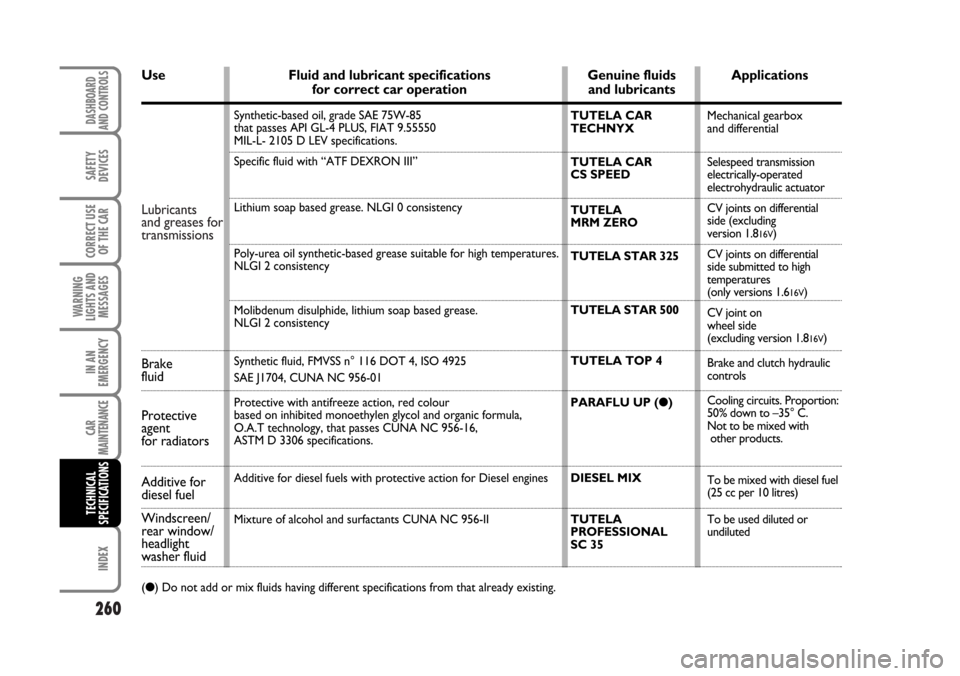
Lubricants
and greases for
transmissions
260
WARNING
LIGHTS AND
MESSAGES
INDEX
DASHBOARD
AND CONTROLS
SAFETY
DEVICES
CORRECT USE
OF THE CAR
IN AN
EMERGENCY
CAR
MAINTENANCE
TECHNICAL
SPECIFICATIONS
Use Fluid and lubricant specifications Genuine fluids Applicationsfor correct car operation and lubricants
(●) Do not add or mix fluids having different specifications from that already existing.Synthetic-based oil, grade SAE 75W-85
that passes API GL-4 PLUS, FIAT 9.55550
MIL-L- 2105 D LEV specifications.
Specific fluid with “ATF DEXRON III”
Lithium soap based grease. NLGI 0 consistency
Poly-urea oil synthetic-based grease suitable for high temperatures.
NLGI 2 consistency
Molibdenum disulphide, lithium soap based grease.
NLGI 2 consistency
Synthetic fluid, FMVSS n° 116 DOT 4, ISO 4925
SAE J1704, CUNA NC 956-01
Protective with antifreeze action, red colour
based on inhibited monoethylen glycol and organic formula,
O.A.T technology, that passes CUNA NC 956-16,
ASTM D 3306 specifications.
Additive for diesel fuels with protective action for Diesel engines
Mixture of alcohol and surfactants CUNA NC 956-IITUTELA CAR
TECHNYX
TUTELA CAR
CS SPEED
TUTELA
MRM ZERO
TUTELA STAR 325
TUTELA STAR 500
TUTELA TOP 4
PARAFLU UP (●)
DIESEL MIX
TUTELA
PROFESSIONAL
SC 35Mechanical gearbox
and differential
Selespeed transmission
electrically-operated
electrohydraulic actuator
CV joints on differential
side (excluding
version 1.8
16V)
CV joints on differential
side submitted to high
temperatures
(only versions 1.6
16V)
CV joint on
wheel side
(excluding version 1.8
16V)
Brake and clutch hydraulic
controls
Cooling circuits. Proportion:
50% down to –35° C.
Not to be mixed with
other products.
To be mixed with diesel fuel
(25 cc per 10 litres)
To be used diluted or
undiluted
Windscreen/
rear window/
headlight
washer fluid Additive for
diesel fuel Protective
agent
for radiators Brake
fluid
Page 265 of 274
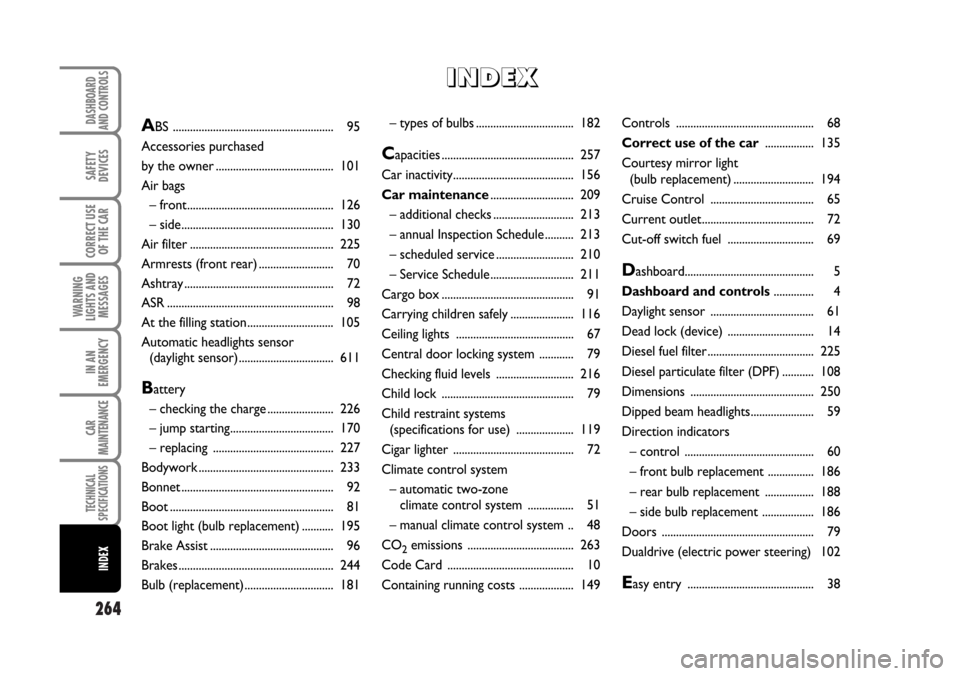
264
WARNING
LIGHTS AND
MESSAGES
DASHBOARD
AND CONTROLS
SAFETY
DEVICES
CORRECT USE
OF THE CAR
IN AN
EMERGENCY
CAR
MAINTENANCE
TECHNICAL
SPECIFICATIONS
INDEX
– types of bulbs .................................. 182
Capacities .............................................. 257
Car inactivity.......................................... 156
Car maintenance............................. 209
– additional checks ............................ 213
– annual Inspection Schedule .......... 213
– scheduled service ........................... 210
– Service Schedule ............................. 211
Cargo box .............................................. 91
Carrying children safely ...................... 116
Ceiling lights ......................................... 67
Central door locking system ............ 79
Checking fluid levels ........................... 216
Child lock .............................................. 79
Child restraint systems
(specifications for use) .................... 119
Cigar lighter .......................................... 72
Climate control system
– automatic two-zone
climate control system ................ 51
– manual climate control system .. 48
CO
2emissions ..................................... 263
Code Card ............................................ 10
Containing running costs ................... 149Controls ................................................ 68
Correct use of the car................. 135
Courtesy mirror light
(bulb replacement) ............................ 194
Cruise Control .................................... 65
Current outlet....................................... 72
Cut-off switch fuel .............................. 69
Dashboard............................................. 5
Dashboard and controls.............. 4
Daylight sensor .................................... 61
Dead lock (device) .............................. 14
Diesel fuel filter ..................................... 225
Diesel particulate filter (DPF) ........... 108
Dimensions ........................................... 250
Dipped beam headlights...................... 59
Direction indicators
– control ............................................. 60
– front bulb replacement ................ 186
– rear bulb replacement ................. 188
– side bulb replacement .................. 186
Doors ..................................................... 79
Dualdrive (electric power steering) 102
Easy entry ............................................ 38
ABS ........................................................ 95
Accessories purchased
by the owner ......................................... 101
Air bags
– front................................................... 126
– side..................................................... 130
Air filter .................................................. 225
Armrests (front rear) .......................... 70
Ashtray .................................................... 72
ASR .......................................................... 98
At the filling station .............................. 105
Automatic headlights sensor
(daylight sensor) ................................. 611
Battery
– checking the charge ....................... 226
– jump starting.................................... 170
– replacing .......................................... 227
Bodywork ............................................... 233
Bonnet ..................................................... 92
Boot ......................................................... 81
Boot light (bulb replacement) ........... 195
Brake Assist ........................................... 96
Brakes ...................................................... 244
Bulb (replacement)............................... 181
I I
N N
D D
E E
X X
Page 267 of 274
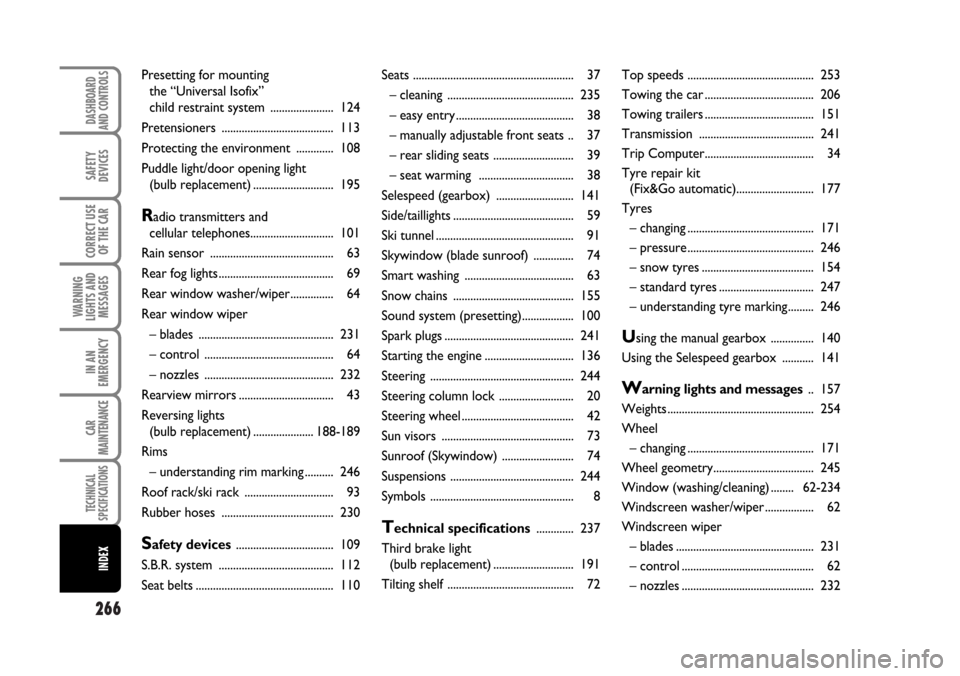
266
WARNING
LIGHTS AND
MESSAGES
DASHBOARD
AND CONTROLS
SAFETY
DEVICES
CORRECT USE
OF THE CAR
IN AN
EMERGENCY
CAR
MAINTENANCE
TECHNICAL
SPECIFICATIONS
INDEX
Seats ........................................................ 37
– cleaning ............................................ 235
– easy entry ......................................... 38
– manually adjustable front seats .. 37
– rear sliding seats ............................ 39
– seat warming ................................. 38
Selespeed (gearbox) ........................... 141
Side/taillights .......................................... 59
Ski tunnel ................................................ 91
Skywindow (blade sunroof) .............. 74
Smart washing ...................................... 63
Snow chains .......................................... 155
Sound system (presetting).................. 100
Spark plugs ............................................. 241
Starting the engine ............................... 136
Steering .................................................. 244
Steering column lock .......................... 20
Steering wheel ....................................... 42
Sun visors .............................................. 73
Sunroof (Skywindow) ......................... 74
Suspensions ........................................... 244
Symbols .................................................. 8
Technical specifications............. 237
Third brake light
(bulb replacement) ............................ 191
Tilting shelf ............................................ 72Top speeds ............................................ 253
Towing the car ...................................... 206
Towing trailers ...................................... 151
Transmission ........................................ 241
Trip Computer...................................... 34
Tyre repair kit
(Fix&Go automatic)........................... 177
Tyres
– changing ............................................ 171
– pressure ............................................ 246
– snow tyres ....................................... 154
– standard tyres ................................. 247
– understanding tyre marking......... 246
Using the manual gearbox ............... 140
Using the Selespeed gearbox ........... 141
Warning lights and messages.. 157
Weights ................................................... 254
Wheel
– changing ............................................ 171
Wheel geometry................................... 245
Window (washing/cleaning) ........ 62-234
Windscreen washer/wiper ................. 62
Windscreen wiper
– blades ................................................ 231
– control .............................................. 62
– nozzles .............................................. 232 Presetting for mounting
the “Universal Isofix”
child restraint system ...................... 124
Pretensioners ....................................... 113
Protecting the environment ............. 108
Puddle light/door opening light
(bulb replacement) ............................ 195
Radio transmitters and
cellular telephones............................. 101
Rain sensor ........................................... 63
Rear fog lights ........................................ 69
Rear window washer/wiper............... 64
Rear window wiper
– blades ............................................... 231
– control ............................................. 64
– nozzles ............................................. 232
Rearview mirrors ................................. 43
Reversing lights
(bulb replacement) ..................... 188-189
Rims
– understanding rim marking .......... 246
Roof rack/ski rack ............................... 93
Rubber hoses ....................................... 230
Safety devices.................................. 109
S.B.R. system ........................................ 112
Seat belts ................................................ 110